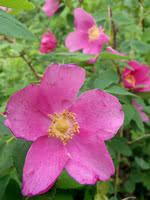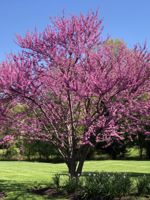Mon-Fri 9am - 5pm Mountain time
Hedge Rose vs Eastern Redbud
Rosa rugosa x Rosa woodsii (Improved hybrid developed by PFRA)
Cercis canadensis
Hedge Rose is a long-lived, fast-growing shrub. It bears similar flowers to the Alberta Wild Rose. Birds will love its deep red rose hips. Hedge Rose will thrive in a wide variety of soils and is a tall rose forming a useful hedge.
Excellent for shelterbelts, ecobuffers, and wildlife habitat plantings. Continuous flowering makes it attractive to pollinators. Many song and game birds utilize this tree for food and habitat.
In use since the early 1900s, this hybrid was originally developed at the PFRA's Indian Head Agroforestry Center.
The Eastern Redbud is known for the pea-like pink buds that emerge in clusters on the bark, embellishing the tree in stunning flowers. They have a longer bloom time, sometimes for two to three weeks before the heart-shaped leaves emerge for the summer. Inedible pods emerge that turn brown in the summer, this tree is a part of the bean family.
Native to the Eastern North America. The Eastern Redbud can tolerate acidic and alkaline soil. Plant this as a beautiful understory species or shaded residential yard or garden. The bright pop of color will make an attractive ornamental tree.
Hedge Rose Quick Facts
Eastern Redbud Quick Facts
In row spacing: 0.3 m (1.0 ft)

